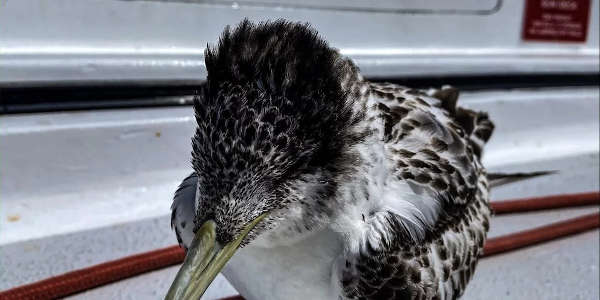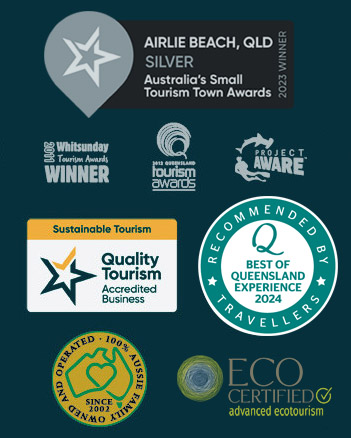Terns are seabirds which can be found worldwide. They belong to the family Laridae which includes other seabirds such as gulls, noddies and skimmers. Due to human impacts most species are now exhibiting population declines. These impacts include habitat destruction, disturbance, pollution and introducing predators into the tern’s environment. They were also historically targeted by humans for their eggs and for their feathers which were used to make clothing. As a result of this several species are now listed as endangered and one as critically endangered. One of the species of turn that can be spotted here in the Whitsundays is the crested turn. This species is the second largest of all the terns and also one of the most commonly sighted in Australia.
As mentioned above this species is quite large as far as terns go and will have a wingspan of up to 50 centimeters and weigh in at almost 400 grams when fully grown. Their plumage is white on the face, neck and underside with a light gray back and wings. On the head they also have a black crest which is where their common name comes from. They also have a long yellow bill and black legs. Both males and females are physically identical and cannot be distinguished from one another. Juveniles however are more distinct. Their upper plumage is heavily mottled with grey, brown and white and they have a mottled black crest and mask.
The crested turn can be found in temperate and tropical throughout the Indian Ocean, Southern Ocean and west Central Pacific Ocean. These guys are not generally migratory like other sea birds and will remain in a specific area close to breeding sites. They are commonly spotted flying around or on islands, beaches, lakes and inlets. Offshore islands are their preferred breeding habitats.
Breeding occurs in colonies and often occurs in close proximity with other seabird species who frequent offshore islands. The male will select and prepare a nesting site within the colony and will defend his patch against other males. If a female enters his nesting site, he will perform a mating display. If she approves the pair will build the nest. Their nests are not very elaborate and consist of a shallow unlined hole in the ground. The female will usually lay one egg although it is possible for her to lay two. The eggs are incubated by and tended to by both parents for a period of 25-30 day. Once the eggs hatch both parents will brood and feed them. The chicks will remain with their parents for up to 4 months.

The main food source for the crested tern is small fish. They will also consume squid, crustaceans such as prawns and even the occasional insect. They hunt at sea by soaring over the surface and rapidly plunging down into the water once a tasty prey animal has been spotted. Once the animal has been caught the tern will fly back up and swallow it whole while midair. They have also adapted to human activities like commercial fishing and will follow trawlers and eat discarded fish.
These terns are one of the most commonly sighted sea birds in the Whitsundays. They can be spotted flying around the waters surrounding the islands in search of their next tasty meal, sitting on the shoreline or you may even be lucky enough to have one come and land on your boat for a bit to rest its wings after a long flight. If one of these birds does happen to use your boat as a rest stop it is important that it is not disturbed or interfered with, once they are ready the bird will fly off on its own.



